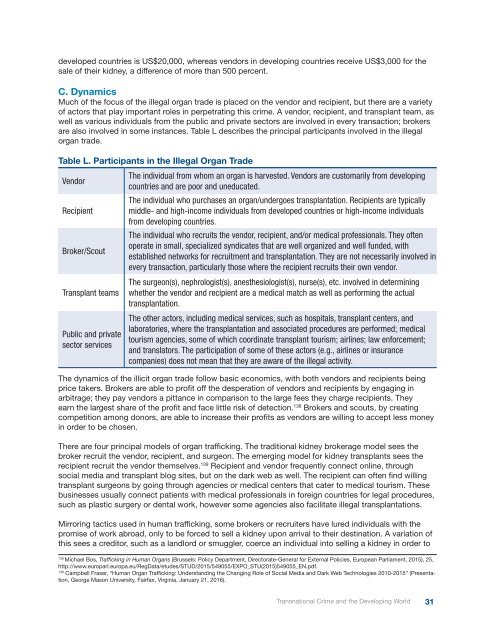Transnational Crime and the Developing World
Transnational_Crime-final
Transnational_Crime-final
You also want an ePaper? Increase the reach of your titles
YUMPU automatically turns print PDFs into web optimized ePapers that Google loves.
developed countries is US$20,000, whereas vendors in developing countries receive US$3,000 for <strong>the</strong><br />
sale of <strong>the</strong>ir kidney, a difference of more than 500 percent.<br />
C. Dynamics<br />
Much of <strong>the</strong> focus of <strong>the</strong> illegal organ trade is placed on <strong>the</strong> vendor <strong>and</strong> recipient, but <strong>the</strong>re are a variety<br />
of actors that play important roles in perpetrating this crime. A vendor, recipient, <strong>and</strong> transplant team, as<br />
well as various individuals from <strong>the</strong> public <strong>and</strong> private sectors are involved in every transaction; brokers<br />
are also involved in some instances. Table L describes <strong>the</strong> principal participants involved in <strong>the</strong> illegal<br />
organ trade.<br />
Table L. Participants in <strong>the</strong> Illegal Organ Trade<br />
Vendor<br />
Recipient<br />
Broker/Scout<br />
Transplant teams<br />
Public <strong>and</strong> private<br />
sector services<br />
The individual from whom an organ is harvested. Vendors are customarily from developing<br />
countries <strong>and</strong> are poor <strong>and</strong> uneducated.<br />
The individual who purchases an organ/undergoes transplantation. Recipients are typically<br />
middle- <strong>and</strong> high-income individuals from developed countries or high-income individuals<br />
from developing countries.<br />
The individual who recruits <strong>the</strong> vendor, recipient, <strong>and</strong>/or medical professionals. They often<br />
operate in small, specialized syndicates that are well organized <strong>and</strong> well funded, with<br />
established networks for recruitment <strong>and</strong> transplantation. They are not necessarily involved in<br />
every transaction, particularly those where <strong>the</strong> recipient recruits <strong>the</strong>ir own vendor.<br />
The surgeon(s), nephrologist(s), anes<strong>the</strong>siologist(s), nurse(s), etc. involved in determining<br />
whe<strong>the</strong>r <strong>the</strong> vendor <strong>and</strong> recipient are a medical match as well as performing <strong>the</strong> actual<br />
transplantation.<br />
The o<strong>the</strong>r actors, including medical services, such as hospitals, transplant centers, <strong>and</strong><br />
laboratories, where <strong>the</strong> transplantation <strong>and</strong> associated procedures are performed; medical<br />
tourism agencies, some of which coordinate transplant tourism; airlines; law enforcement;<br />
<strong>and</strong> translators. The participation of some of <strong>the</strong>se actors (e.g., airlines or insurance<br />
companies) does not mean that <strong>the</strong>y are aware of <strong>the</strong> illegal activity.<br />
The dynamics of <strong>the</strong> illicit organ trade follow basic economics, with both vendors <strong>and</strong> recipients being<br />
price takers. Brokers are able to profit off <strong>the</strong> desperation of vendors <strong>and</strong> recipients by engaging in<br />
arbitrage; <strong>the</strong>y pay vendors a pittance in comparison to <strong>the</strong> large fees <strong>the</strong>y charge recipients. They<br />
earn <strong>the</strong> largest share of <strong>the</strong> profit <strong>and</strong> face little risk of detection. 138 Brokers <strong>and</strong> scouts, by creating<br />
competition among donors, are able to increase <strong>the</strong>ir profits as vendors are willing to accept less money<br />
in order to be chosen.<br />
There are four principal models of organ trafficking. The traditional kidney brokerage model sees <strong>the</strong><br />
broker recruit <strong>the</strong> vendor, recipient, <strong>and</strong> surgeon. The emerging model for kidney transplants sees <strong>the</strong><br />
recipient recruit <strong>the</strong> vendor <strong>the</strong>mselves. 139 Recipient <strong>and</strong> vendor frequently connect online, through<br />
social media <strong>and</strong> transplant blog sites, but on <strong>the</strong> dark web as well. The recipient can often find willing<br />
transplant surgeons by going through agencies or medical centers that cater to medical tourism. These<br />
businesses usually connect patients with medical professionals in foreign countries for legal procedures,<br />
such as plastic surgery or dental work, however some agencies also facilitate illegal transplantations.<br />
Mirroring tactics used in human trafficking, some brokers or recruiters have lured individuals with <strong>the</strong><br />
promise of work abroad, only to be forced to sell a kidney upon arrival to <strong>the</strong>ir destination. A variation of<br />
this sees a creditor, such as a l<strong>and</strong>lord or smuggler, coerce an individual into selling a kidney in order to<br />
138<br />
Michael Bos, Trafficking in Human Organs (Brussels: Policy Department, Directorate-General for External Policies, European Parliament, 2015), 25,<br />
http://www.europarl.europa.eu/RegData/etudes/STUD/2015/549055/EXPO_STU(2015)549055_EN.pdf.<br />
139<br />
Campbell Fraser, “Human Organ Trafficking: Underst<strong>and</strong>ing <strong>the</strong> Changing Role of Social Media <strong>and</strong> Dark Web Technologies 2010-2015” (Presentation,<br />
George Mason University, Fairfax, Virginia, January 21, 2016).<br />
<strong>Transnational</strong> <strong>Crime</strong> <strong>and</strong> <strong>the</strong> <strong>Developing</strong> <strong>World</strong> 31


